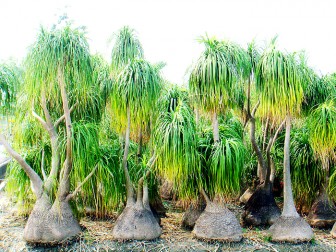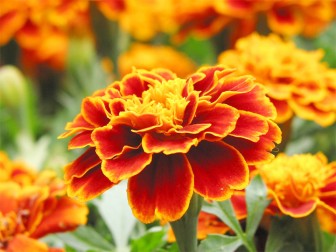Diaries can be repetitious things and I often find that in this diary my memory tells me that I am dealing with things that I have talked about before. Never mind that, because gardening is like that. We are governed by the seasons and we have to respond to the changes in weather patterns each year, and make certain that our plants are cared for accordingly. Problems in the garden throughout the world change very little, only the plants we grow change because they outgrow their allotted space and we plant other things.

Many years ago at Kew Gardens I grew a plant of the Mexican ponytail, Nolina recurvata. Growing on a single stem which can attain six feet it produces the most graceful head of leaves. I acquired another specimen some years ago, and as one might expect by now it has been given another name − Beaucarnea recurvate — which is a nuisance. Mexican ponytails are curious plants developing a large swollen base to the stem for storing water – a useful development in Guyana during the ‘dry’ season. Mexican ponytails produce the most graceful foliage, and would be valuable as part of a well-lit modern interior decor (requiring little water), or a small patio, or even a prominent slightly drier spot, for it is a slow grower. Any halfway decent catalogue will list it, and it grows very quickly from seed. If you get a chance, buy one or more.
If you have the water to spare and you find that some plants are getting desperate for it, put plenty of water around the roots. Just a little bit will merely evaporate and you must give them very generous quantities, but this evaporation can be reduced if you can put a good deal of compost into the ground. This will help the ground retain water and encourage worm activity. Do this watering in the late afternoon and do it slowly enough so it doesn’t run off the surface, but just soaks in.

Fertilizer should not be given at the start of the dry season but right at the end of it. The reason for this is that the roots may well be scorched if the ground is really dry. Slightly moist ground, as will quickly occur once the rains start again, is ideal for growth to begin.
I have in the past received many of what I call sunshine plants all of which require to be grown in well-drained soil, not in pro mix. Especially good are the Transvaal daisies (Gerbera varieties), and once they have settled down they can be planted out. Also in this group are the dianthus (a small carnation which grows superbly in a well-drained rockery), some good plants of Salvia splendens with spikes of scarlet flowers, and a good selection of good quality petunia plants, excellent for hanging baskets, tubs or window boxes and placed around the house in places not exposed to the sun.
Try your hand at growing various herbs in pots especially thyme, parsley, sweet basil, and spearmint, all of which are used regularly in cooking, and all having the most delightful scented leaves. ‘Erbs,’ as our American cousins insist on pronouncing it, have become a great feature in many great gardens, many being displayed with collections of other scented plants for the sight impaired.
Until next week may your God go with you.









